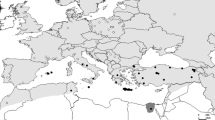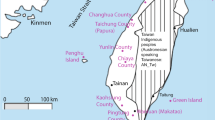Abstract
We reexamined Tamias sibiricus barberi from Korea by sequencing c-myc exon 2 and the mtDNA control region. In the c-myc exon, the monogenic T. s. barberi differed from the monogenic T. s. orientalis (nucleotide distance 0.48%; 3 variable sites at 168, 306, and 552), whereas T. s. orientalis was identical to T. s. sibiricus. In the control region, T. s. barberi differed from T. s. orientalis (distance 6.84%) and T. s. sibiricus (9.35%). We considered the concordant, extensive gaps between the phylogroup of T. s. barberi and other subspecies of T. sibiricus in the c-myc gene, control region, and cytochrome b gene to be evidence of a lack of intergradation through North Korea from T. s. barberi to T. s. orientalis. Our results, showing the genetic and morphological distinctness of T. s. barberi, support that this phylogroup is a distinct species.


Similar content being viewed by others
References
Avise JC, Walker D (1999) Species realities and numbers in sexual vertebrates: perspectives from an asexual transmitted genome. Proc Acad Nat Sci USA 96:992–995
Baker RJ, Bradley RD (2006) Speciation in mammals and the genetic species concept. J Mamm 87:643–662
Brown WM (1985) The mitochondrial genome of animals. In: MacIntyre RJ (ed) Molecular evolutionary genetics. Plenum, New York, pp 95–130
Chung CH (2007) Vegetation response to climate change on Jeju Island, South Korea, during the last deglaciation based on pollen record. Geosci J 11:147–155
Corbet GB (1978) The mammals of the Palaearctic region: a taxonomic review. British Mus (Nat Hist), Cornell University Press, London, pp 137–138
Ellerman JR, Morrison-Scott TCS (1951) Check-list of Palaearctic and Indian Mammals 1758–1946. British Mus (Nat Hist), London, pp 503–504
Hillis DM, Moritz C, Mable BK (1996) Molecular systematics, 2nd edn. Sinauer Associates, New York, p 655
Hoffmann RS, Anderson CG, Thorington RW, Heaney LR (1993) Family Sciuridae. In: Wilson DE, Reeder DM (eds) Mammal species of the world: a taxonomic and geographic reference. Smithsonian Institution Press, Washington, DC, p 455
Huelsenbeck JP, Bull JJ, Cunningham CW (1996) Combining data in phylogenetic analysis. TREE 11:152–157
Irwin DM, Kocher TD, Wilson AC (1991) Evolution of the cytochrome b gene of mammals. J Mol Evol 32:128–144
Jones JK, Johnson DH (1965) Synopsis of the lagomorphs and rodents of Korea. University of Kansas Publication Mus (Nat Hist) 16:357–407
Koh HS, Randi E (2001) Genetic distinction of roe-deer (Capreolus pygargus Pallas) sampled from Korea. Mamm Biol 66:371–375
Koh HS, Chun TY, Yoo HS, Zhang Y, Wang J, Zhang M, Wu C (2001) Mitochondrial cytochrome b gene sequence diversity in the Korean hare, Lepus coreanus Thomas (Mammalia, Lagomorpha). Biochem Genet 39:417–429
Koh HS, Wang J, Lee BK, Yang BG, Heo SW, Jang KH, Chun TY (2009) A phylogroup of the Siberian chipmunk from Korea (Tamias sibiricus barberi) revealed from the mitochondrial DNA cytochrome b gene. Biochem Genet 47:1–7
Lee MY, Lissovsky AA, Park S, Obolenskaya EV, Dokuchaev NE, Zhang Y, Yu L, Kim Y, Voloshina I, Myslenkov A, Choi T, Min M, Lee H (2008) Mitochondrial cytochrome b sequence variations and population structure of Siberian chipmunk (Tamias sibiricus) in northeastern Asia and population substructure in South Korea. Mol Cells 26:566–575
Mallet J, Willmott K (2003) Taxonomy: renaissance or Tower of Babel? TREE 18:57–59
Miyamoto MM, Porter CA, Goodman M (2000) C-myc gene sequence and the phylogeny of bats and other eutherian mammals. Syst Biol 49:501–504
Nowak RM (1999) Walker’s mammals of the world, 6th edn. Johns Hopkins University Press, London, p 1247
Patterson BD, Heaney LR (1987) Preliminary analysis of geographic variation in red-tailed chipmunks (T. ruficaudus). J Mamm 68:782–791
Piaggio AJ, Spicer GS (2001) Molecular phylogeny of the chipmunks inferred from mitochondrial cytochrome b and cytochrome oxidase II gene sequences. Mol Phylogenet Evol 20:335–350
Rowe KC, Heske EJ, Brown PW, Paige KN (2004) Surviving the ice: northern refugia and postglacial colonization. Proc Natl Acad Sci USA 101:10355–10359
Rubinoff D, Holland BS (2005) Between two extremes: mitochondrial DNA is neither the panacea nor the nemesis of phylogenetic and taxonomic inference. Syst Biol 54:952–961
Slimen HB, Suchentrunk F, Elgaaied ABA (2008) On shortcomings of using mtDNA sequence for the systematics of hares (genus Lepus): an example from cape hares. Mamm Biol 73:25–32
Steppan SC, Storz BL, Hoffmann RS (2004) Nuclear DNA phylogeny of the squirrels (Mammalia; Rodentia) and the evolution of arboreality from c-myc and RAG1. Mol Phylogenet Evol 30:703–719
Stewart DT, Baker AJ (1994) Pattern of sequence variation in the mitochondrial D-loop region of shrews. Mol Biol Evol 11:9–21
Sunnucks P (2000) Efficient genetic markers for population biology. TREE 15:199–203
Tamura K, Nei M (1993) Estimation of the number of nucleotide substitutions in the control region of mitochondrial DNA in humans and chimpanzees. Mol Biol Evol 10:512–526
Tate GHH (1947) Mammals of Eastern Asia. MacMillan Co., New York, p 235
Vogler AP, Monaghan MT (2006) Recent advances in DNA taxonomy. J Zool Syst Evol Res 45:1–10
Author information
Authors and Affiliations
Corresponding author
Rights and permissions
About this article
Cite this article
Koh, H.S., Zhang, M., Bayarlkhagva, D. et al. Concordant Genetic Distinctness of the Phylogroup of the Siberian Chipmunk from the Korean Peninsula (Tamias sibiricus barberi), Reexamined with Nuclear DNA c-myc Gene Exon 2 and mtDNA Control Region Sequences. Biochem Genet 48, 696–705 (2010). https://doi.org/10.1007/s10528-010-9352-1
Received:
Accepted:
Published:
Issue Date:
DOI: https://doi.org/10.1007/s10528-010-9352-1




